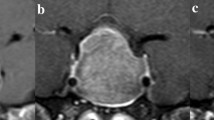Abstract
Purpose
Recent work supports the use of T2-weighted MRI intensity as a tool for treatment stratification in acromegaly. Our study aimed to establish if the pattern of T2 intensity could be a predictor of hormonal and/or tumoral response to dopamine agonists (DAs) in prolactinomas.
Methods
This was a retrospective study performed in two academic centers. We characterized the magnetic resonance T2-weighted aspect of prolactinomas (signal intensity and homogeneity in the whole tumors) before DA therapy and correlated this pattern to the prolactin (PRL) concentration at diagnosis and to hormonal and tumoral responses after 1 year of medical treatment. We separately analyzed a subgroup of prolactinomas visually very bright in more than 50% of the surface (“cystic” tumors).
Results
Out of 70 prolactinomas, 80% were T2 hyperintense and 40% were heterogeneous. At diagnosis, heterogeneous prolactinomas were more frequent in men (68% vs. 28.9%, p ≤ 0.011), larger (median area 304.5 mm2 vs. 56.5 mm2, p ≤ 0.021), taller (mean height 18.6 mm vs. 9.9 mm, p < 0.001), more secreting (median PRL ULN_area 23 µg/L/cm2 vs. 12.6 µg/L/cm2, p ≤ 0.032) and had poorer hormonal response to DA as compared with homogeneous prolactinomas. “Cystic” tumors were diagnosed almost exclusively in women and secreted less prolactin, but showed similar hormonal and tumoral response as “non-cystic” tumors. In homogeneous prolactinomas, the T2-weighted intensity ratio was correlated to prolactin secretion, although not significantly, and did not predict hormonal and tumoral response to DA.
Conclusions
Our study confirms that hypo/isointense prolactinoma is a rare finding and suggests for the first time that the heterogeneity of prolactinoma T2 signal at diagnosis might be correlated with a different clinical behavior and could be used as a negative predictor factor of hormonal response to DA.



Similar content being viewed by others
References
E. Delgrange, T. Daems, J. Verhelst, R. Abs, D. Maiter, Characterization of resistance to the prolactin-lowering effects of cabergoline in prolactinomas: a study in 122 patients. Eur. J. Endocrinol. 5, 747–752 (2009)
I. Potorac, A. Beckers, J.F. Bonneville, T2-weighted MRI signal intensity as a predictor of hormonal and tumoral responses to somatostatin receptor ligands in acromegaly: a perspective. Pituitary 20, 116–120 (2017)
A. Hagiwara, Y. Inoue, K. Wakasa, T. Haba, T. Tashiro, T. Miyamoto, Comparison of growth hormone-producing and non-growth hormone-producing adenomas: imaging characteristics and pathologic correlation. Radiology 228, 533–538 (2003)
I. Potorac, P. Petrossians, A.F. Daly et al. Pituitary MRI characteristics in 297 acromegaly patients based on T2-weighted sequences. Endocr. Relat. Cancer 22, 169–177 (2015)
A. Heck, K.E. Emblem, O. Casar-Borota, J. Bollerslev, G. Ringstad, Quantitative analyses of T2-weighted MRI as a potential marker for response to somatostatin analogs in newly diagnosed acromegaly. Endocrine 52, 333–343 (2016)
A. Heck, K.E. Emblem, O. Casar-Borota, G. Ringstad, J. Bollerslev, MRI T2 characteristics in somatotroph adenomas following somatostatin analog treatment in acromegaly. Endocrine 53, 327–330 (2016)
J. Kreutz, L. Vroonen, F. Cattin et al.Intensity of prolactinoma on T2-weighted magnetic resonance imaging: towards another gender difference. Neuroradiology 57, 679–684 (2015)
A. Heck, G. Ringstad, S.L. Fougner et al.Intensity of pituitary adenoma on T2-weighted magnetic resonance imaging predicts the response to octreotide treatment in newly diagnosed acromegaly. Clin. Endocrinol. (Oxf.). 77, 72–78 (2012)
S.L. Fougner, O. Casar-Borota, A. Heck, J.P. Berg, J. Bollerslev, Adenoma granulation pattern correlates with clinical variables and effect of somatostatin analogue treatment in a large series of patients with acromegaly. Clin. Endocrinol. (Oxf.). 76, 96–102 (2012)
G. Raverot, E. Jouanneau, J. Trouillas, Management of endocrine disease: clinicopathological classification and molecular markers of pituitary tumors for personalized therapeutic strategies. Eur. J. Endocrinol. 170, 121–132 (2014)
H. Buurman, W. Saeger, Subclinical adenomas in postmortem pituitaries: classification and correlations to clinical data. Eur. J. Endocrinol. 154, 753–758 (2006)
H. Nishioka, J. Haraoka, K. Akada, S. Azuma, Gender-related differences in prolactin secretion in pituitary prolactinomas. Neuroradiology 44, 407–410 (2002)
D.M. Yousem, J.A. Arrington, S.J. Zinreich, A.J. Kumar, R.N. Bryan, Pituitary adenomas: possible role of bromocriptine in intratumoral hemorrhage. Radiology 170, 239–243 (1989)
P. Lundin, K. Bergström, R. Nyman, P.O. Lundberg, C. Muhr, Macroprolactinomas: serial MRI imaging in long-term bromocriptine therapy. AJNR Am. J. Neuroradiol. 13, 1279–1291 (1992)
K.N. Sarwar, M.S. Huda, V. Van de Velde et al. The prevalence and natural history of pituitary hemorrhage in prolactinoma. J. Clin. Endocrinol. Metab. 98, 2362–2367 (2013)
L. Symon, S. Mohanty, Haemorrhage in pituitary tumors. Acta Neurochir. (Wien.) 65, 41–49 (1982)
P.L. Semple, J.A. Jane, M.B. Lopes, E.R. Laws, Pituitary apoplexy: correlation between magnetic resonance imaging and histopathological results. J. Neurosurg. 108, 909–915 (2008)
A.S. Dubuisson, A. Beckers, A. Stevenaert, Classical pituitary tumor apoplexy: clinical features, management and outcomes in a series of 24 patients. Clin. Neurol. Neurosurg. 109, 63–70 (2007)
E. Delgrange, J. Trouillas, D. Maiter, J. Donckier, J. Tourniaire, Sex-related difference in the growth of prolactinomas: a clinical and proliferation marker study. J. Clin. Endocrinol. Metab. 82, 2102–2107 (1997)
A. Faje, P. Chunharojrith, J. Nency, B.M. Biller, B. Swearingen, A. Klibanski, Dopamine agonists can reduce cystic prolactinomas. J. Clin. Endocrinol. Metab. 101, 3709–3715 (2016)
Author information
Authors and Affiliations
Corresponding author
Ethics declarations
Conflict of interest
The authors declare that they have no conflict of interest.
Ethical approval
All procedures performed in studies involving human participants were in accordance with the ethical standards of the institutional and/or national research committee and with the 1964 Helsinki declaration and its later amendments or comparable ethical standards.
Informed consent
Informed consent was obtained from all individual participants included in the study.
Electronic supplementary material
Rights and permissions
About this article
Cite this article
Burlacu, M.C., Maiter, D., Duprez, T. et al. T2-weighted magnetic resonance imaging characterization of prolactinomas and association with their response to dopamine agonists. Endocrine 63, 323–331 (2019). https://doi.org/10.1007/s12020-018-1765-3
Received:
Accepted:
Published:
Issue Date:
DOI: https://doi.org/10.1007/s12020-018-1765-3




